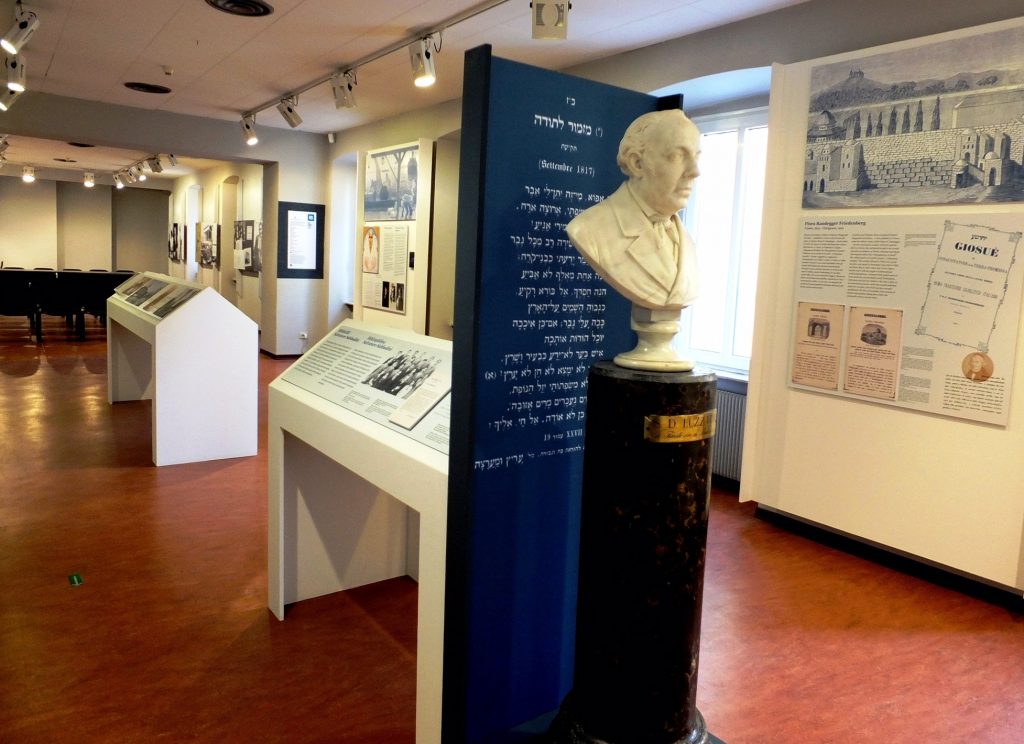Trieste’s Jewish cultural institutions are very active, tackling numerous contemporary challenges, particularly over the last two years. We meet Jewish Museum of Trieste‘s curator Annalisa Di Fant to discuss European Jewish Culture Days, the fight against anti-Semitism and the remarkable story of how the Umberto Saba bookshop was saved.

Jguideeurope: Which cultural events will be organized for the EDJC?
Annalisa Di Fant: The Museum has recently renovated the exhibition rooms on the second floor, which now have brand new wooden flooring. They will be inaugurated on the occasion of the 2025 EDJC. As this year the EDJC is dedicated to the People of the Book, some significant books from the Trieste Jewish Community Library will be on display to the public.
Despite the looting suffered during the Nazi occupation, it is a remarkable library, whose core began to be established in the second half of the 18th century and reflects the complex history of the Jews in the city. It consists of about 4,000 volumes, mostly written in Hebrew, which have recently been catalogued as part of the UCEI project “I-tal-ya books”.
Just two examples of what people will see in our little exhibit: the first Italian translation of 1812 Benè Zion by N. Herz Homberg, published by Leone Vita Saraval (Trieste 1815) and a volume of the Viennese Kochbe Yitzhak (‘The Stars of Isaac’) from 1852, in which the poems of Rachel Luzzatto Morpurgo from Trieste were published.
Do you feel such events are particularly important in order to fight the rise of antisemitism in Europe?
It is precisely initiatives such as the EDJC that can help the non-Jewish public understand how varied and diverse the Jewish cultural heritage of the Diaspora is and how closely it is intertwined with the culture of different geographical areas and cities.
Knowledge of Jewish history and culture helps to disarm anti-Semitism, even though at present there is unfortunately a strong counter current and a priori rejection of everything that is “Jewish”. Particularly serious is the boycott of cultural institutions such as our museum, which for example is being deserted by some of the schools that used to bring their students here.

Can you tell us about the wonderful initiative in 2025 that enabled to save the Umberto Saba bookshop?
The Antiquarian Bookshop founded by the poet Umberto Saba in 1919 is a veritable treasure trove of culture: almost 30,000 books, both ancient and recent. After his death in 1957, ownership and management passed to his long-time clerk, Carlo Cerne, and then to his son Mario, who died in January 2024. For more than a century, the bookshop has been one of the epicentres of Trieste’s culture and a favourite tourist destination. Now it can return to being just that: it reopened to the public on 28 January 2025, after about a year of restoration work and with new management, entrusted by Ada Cerne to the devoted bibliophile Massimo Battista.
The Jewish Community of Trieste, which owns the premises, commissioned architect Aulo Guagnini to design and direct a philological restoration (completely redone floors and systems, carefully restored furniture and wallpaper), which was financed thanks to the support of foundations (Beneficentia Stiftung and Fondazioni Benefiche Alberto e Kathleen Casali, companies (Samer & Co Shipping) and private citizens determined to save one of the most beloved symbols of local culture. The help provided by dozens of young volunteers in moving the books was also remarkable.
Which place linked to Trieste’s Jewish heritage should be better known?
The Jewish cemetery, which has been in its current location since 1843, is another symbolic place in local Jewish history. Surrounded by lush vegetation, this large cemetery in Via della Pace 4 is a fascinating site that tells the story of the community, starting with the most important families who left their mark on the history of Trieste.
Now, thanks to a project funded by the Friuli Venezia Giulia Region, it will be possible to visit it using an app that allows visitors to enjoy augmented reality in some of the most significant funerary monuments. They will thus be able to access information and images related to the people buried there. As part of this same project, some of the most damaged monuments have been secured and restored, as have the premises used for the preparation of the deceased before burial.
On a broader level, we would like to highlight also the GoJewishGo project, the cross-border initiative with which the Jewish Community of Trieste intends to preserve and promote the stories and memories of the Jewish Communities of the Italian and Slovenian Goritian Area and of Friuli. This project, linked to the role of Gorizia and Nova Gorica as European capitals of culture in 2025, was co-financed by the European Union under the Small Projects Fund GO! 2025 of the Interreg VI-A Italy-Slovenia 2021-2027 Programme, managed by the EGTC GO.